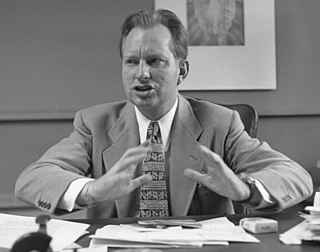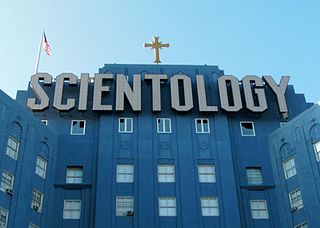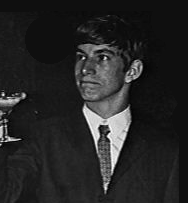
Lafayette Ronald Hubbard was an American author and the founder of Scientology. A prolific writer of pulp science fiction and fantasy novels in his early career, in 1950 he authored Dianetics: The Modern Science of Mental Health and established organizations to promote and practice Dianetics techniques. Hubbard created Scientology in 1952 after losing the rights to Dianetics in bankruptcy proceedings, and would manage the Church of Scientology until his death in 1986. Born in Tilden, Nebraska, in 1911, Hubbard spent much of his childhood in Helena, Montana. While his father was posted to the U.S. naval base on Guam in the late 1920s, Hubbard traveled to Asia and the South Pacific. In 1930, Hubbard enrolled at George Washington University to study civil engineering but dropped out in his second year. He began his career as a prolific writer of pulp fiction stories and married Margaret Grubb, who shared his interest in aviation.

Xenu, also called Xemu, is a figure in the Church of Scientology's secret "Advanced Technology", a sacred and esoteric teaching. According to the "Technology", Xenu was the extraterrestrial ruler of a "Galactic Confederacy" who brought billions of his people to Earth in DC-8-like spacecraft 75 million years ago, stacked them around volcanoes, and killed them with hydrogen bombs. Official Scientology scriptures hold that the thetans of these aliens adhere to humans, causing spiritual harm.

Mission Earth is a ten-volume science fiction novel series by L. Ron Hubbard. Hubbard died three months after the publication of volume 1, and other volumes were published posthumously.

In Scientology, the concept of the thetan is similar to the concept of self, or the spirit or soul as found in several belief systems. The term is derived from the Greek letter Θ, theta, which in Scientology beliefs represents "the source of life, or life itself." In Scientology it is believed that it is the thetan, not the central nervous system, which commands the body.
Revolt in the Stars is a science fiction film screenplay written by Scientology founder L. Ron Hubbard in 1977. It tells the space opera story of how an evil galactic dictator, named Xenu, massacres many of his subjects by transporting them to Earth and killing them with atomic bombs. L. Ron Hubbard had already presented this story to his followers, as a true account of events that happened 75 million years ago, in a secret level of Scientology scripture called Operating Thetan, Level III. The screenplay was promoted around Hollywood circles in 1979, but attempts at fundraising and obtaining financing fell through, and the film was never made. Unofficial copies circulate on the Internet.
Russell Miller (born c. 1938) is a British journalist and author of fifteen books, including biographies of Hugh Hefner, J. Paul Getty and L. Ron Hubbard.

Bare-faced Messiah: The True Story of L. Ron Hubbard is a posthumous biography of Scientology founder L. Ron Hubbard by British journalist Russell Miller. First published in the United Kingdom on 26 October 1987, the book takes a critical perspective, challenging the Church of Scientology's account of Hubbard's life and work. It quotes extensively from official documents acquired using the Freedom of Information Act and from Hubbard's personal papers, which were obtained via a defector from Scientology. It was also published in Australia, Canada and the United States.

Geoffrey Quentin McCaully Hubbard, was the son of Scientology founder L. Ron Hubbard and his third wife, Mary Sue Hubbard. He died at the age of 22 in an apparent suicide.

Church of Scientology Celebrity Centres are Churches of Scientology that are open to the general public but are intended for "artists, politicians, leaders of industry, and sports figures".

OT VIII or OT 8 is the highest current auditing level in Scientology. OT VIII is known as "The Truth Revealed" and was first released to select high-ranking public Scientologists in 1988, two years after the death of Scientology's founder, L. Ron Hubbard. OT VIII is only delivered to members of the Church of Scientology in one place—aboard the organization's private cruise ship, the Freewinds, and is additionally available from independent Scientology groups. There are a few advanced auditors that are able to deliver the level to those who meet the prerequisites.

Battlefield Earth: A Saga of the Year 3000 is a 1982 science fiction novel written by L. Ron Hubbard, founder of Scientology. He also composed a soundtrack to the book called Space Jazz.

The Scandal of Scientology is a critical exposé book about the Church of Scientology, written by Paulette Cooper and published by Tower Publications, in 1971.

Final Blackout is a dystopic science fiction novel by American writer L. Ron Hubbard. The novel is set in the future and follows a man known as "the Lieutenant" as he restores order to England after a world war. First published in serialized format in 1940 in the science fiction magazine Astounding Science Fiction, Final Blackout was published in book form in 1948 by The Hadley Publishing Co. Author Services Inc. published a hardcover edition of the book in 1988, and in 1989 the Church of Scientology-affiliated organization Bridge Publications said that a film director named Christopher Cain had signed a contract to write and direct a movie version based on the book.

Typewriter in the Sky is a science fantasy novel by American writer L. Ron Hubbard. The protagonist Mike de Wolf finds himself inside the story of his friend Horace Hackett's book. He must survive conflict on the high seas in the Caribbean during the 17th century, before eventually returning to his native New York City. Each time a significant event occurs to the protagonist in the story he hears the sounds of a typewriter in the sky. At the story's conclusion, de Wolf wonders if he is still a character in someone else's story. The work was first published in a two-part serial format in 1940 in Unknown Fantasy Fiction. It was twice published as a combined book with Hubbard's work Fear. In 1995 Bridge Publications re-released the work along with an audio edition.

L. Ron Hubbard was the inventor of Dianetics and founder of Scientology. Born in Tilden, Nebraska in March 1911, Hubbard grew up with his family in Helena, Montana. He was unusually well-traveled for a young man of his time due to his father's frequent relocations in connection with his service in the United States Navy. He lived in a number of locations in the United States and traveled to Guam, the Philippines, China, and Japan. He enrolled at George Washington University in 1930 to study civil engineering, but dropped out in his second year. While at GWU, he organized an expedition to the Caribbean for fellow students which looms large in his official biography but was a flop according to contemporary accounts. He subsequently spent time in Puerto Rico panning for gold, before returning to the United States, marrying his pregnant girlfriend, and embarking on a career as a "penny-a-word" writer.
Lafayette Ronald Hubbard, better known as L. Ron Hubbard, was an American pulp fiction author. He wrote in a wide variety of genres, including science fiction, fantasy, adventure fiction, aviation, travel, mystery, western, and romance. His United States publisher and distributor is Galaxy Press. He is perhaps best known for his self-help book, the #1 New York Times bestseller Dianetics: The Modern Science of Mental Health, and as the founder of the Church of Scientology.
Pat Broeker, a former high-ranking member of the Church of Scientology, was – along with his wife Annie Broeker – one of the few people in direct contact with L. Ron Hubbard in his final years. He and his wife, and driver Steve "Sarge" Pfauth, left with Hubbard from his home in Hemet, California in 1980 and travelled around California in a motorhome until buying and settling at a ranch in San Luis Obispo County in 1983. The Broekers and Pfauth stayed with Hubbard until his death in January 1986. Due to ongoing investigations by the FBI and IRS following the arrests of high-ranking Scientologists, including Hubbard's wife Mary Sue Hubbard over Operation Snow White, the location of the ranch was kept secret and visits from Church management were forbidden while Hubbard was alive.
L. Ron Hubbard spent the final decade of his life in hiding in various locations throughout the United States.
Scientology founder L. Ron Hubbard made a number of false claims about his life and background. His estranged son Ronald DeWolf (Nibs) reported that "Ninety-nine percent of what my father ever wrote or said about himself" was false. An acquaintance who knew Hubbard in Pasadena recalled recognizing Hubbard's epic autobiographical tales as being adapted from the writings of others. In October 1984, an American judge issued a ruling, writing of Hubbard that "The evidence portrays a man who has been virtually a pathological liar when it comes to his history, background and achievements."










